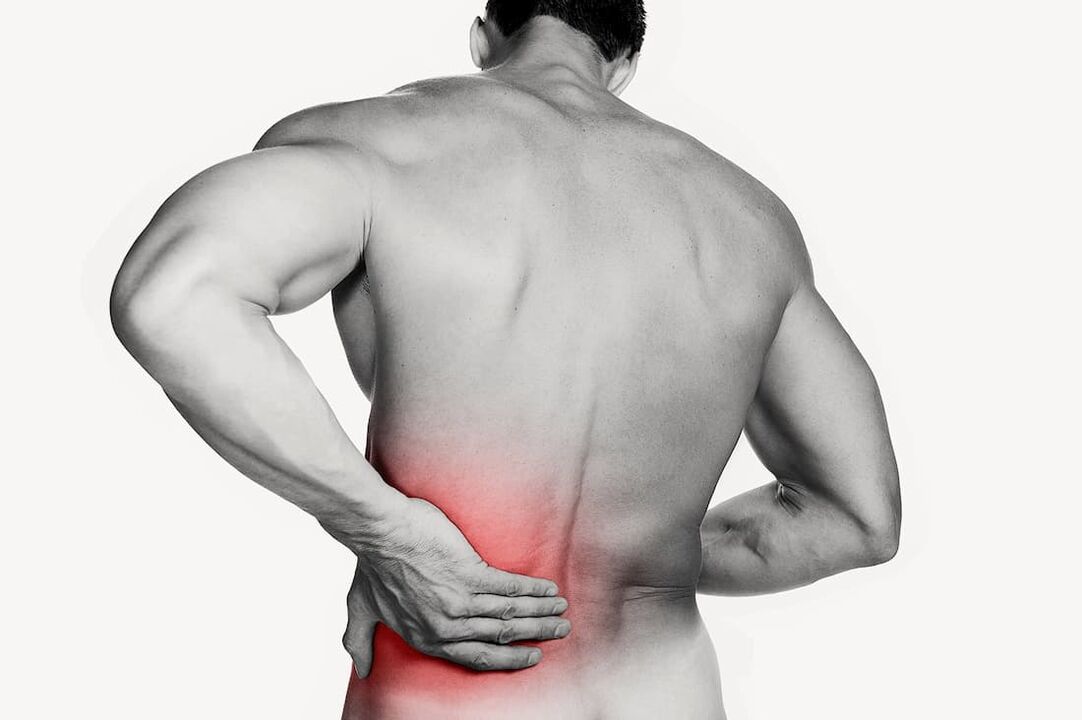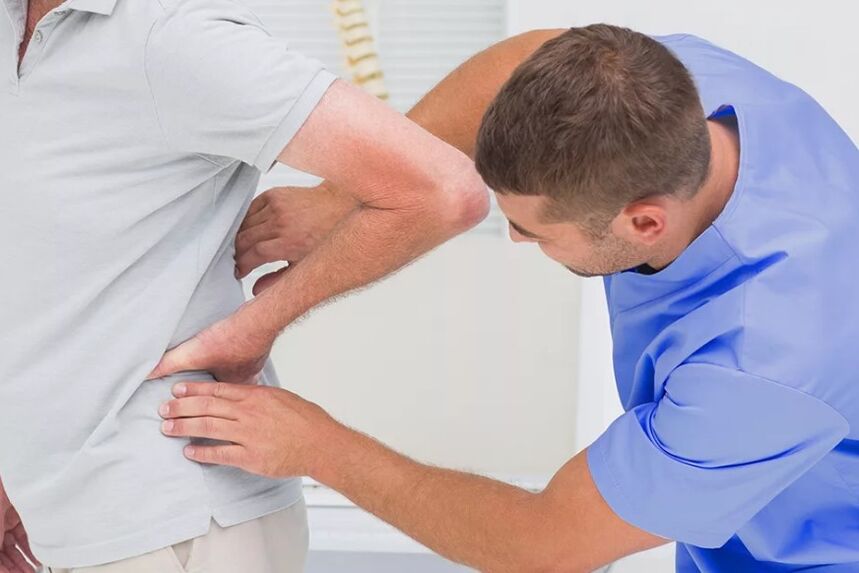
Pain low is a symptom that rarely pays.Most people associate it with work in a sitting position, lifting weights or osteochondrose and do not rush with the doctor.In fact, this condition can signal the kidney diseases, liver or intestines, and the problems with the musculos-bone system will not pass alone.Only a timely inspection of a specialist and complete testing will help identify the causes of pain and choose the right treatment.
General information
The lower back is an area that experiences a significant load due to being in an upright position.Spinal columns are five large vertebrae, which are further reinforced with a muscle framework.9 out of 10 cases of pain in this area is caused by the pathology of muscle-bone system: osteochondrose, muscle cramp, an interverter disc hernia, pushing nerve roots.
The remaining 10% of cases are related to the diseases of the internal bodies located in the lower back projection: kidneys, genitourin system, hoses, liver.Even a doctor, when testing cannot always determine the cause of pain, which is why this condition requires a thorough laboratory and instrumental diagnosis.
Types of pain
The first thing the doctor asks is the nature of the sensation.Depending on the cause that caused, the pain in the lower back may be:
- Acute: usually appears abruptly, characterized by high intensity;The duration of sensations is not more than 1.5 months;
- Subacutely: lasts 6-12 weeks;
- Chronic: the sensations of any intensity lasting 12 or more weeks;
- Transfer: Periodically appears;
- pain;
- stupid;
- Powerful, average intensity, weak.
This division is conditional.Depending on the situation and circumstances, the nature and duration of sensations can vary.It is important to describe them as completely possible.
Reasons
Reasons that make the back begin to hurt in the lower back.The most common provocating factors serve:
- hypothermia;
- Lifting weight;
- Uneven load distribution (against the background of pregnancy, posture disorders, musculosk-bone system);
- Contagious lesions;
- diseases of the muscle-bone system;
- inflammatory processes, including autoimmune;
- Long stay in an unpleasant position;
- Change in bone tissue composition (osteoporosis);
- Volumetric processes: Benigni and malignant tumors, abscesses;
- Hormone changes (menstruation, pregnancy, menopause);
- kidney diseases (urolithiasi, chickenphritis, glomerulonephritis, abscess);
- gastrointestinal tract pathology;
- Uterine diseases and accessories in women, prostate in men, etc.
Diseases
Lower pain can be a symptom of various diseases of the muscle-bone system and internal organs.The main task of the doctor finds out what exactly caused the deterioration of the situation and take the necessary measures.
Here is the pathology that are most often.
Ankilosing spondilitis
This is a system inflammatory disease in which individual vertebrae appear in one conglomerate.At the same time, the deposit of calcium in the ligaments that stabilizes spine, as a result of which the affected area almost completely loses mobility.
Proncased characteristics of lower back pain with ankeposing spondylitis include:
- Increasing intensity at rest, especially with extended findings in a horizontal position;
- Limit of movement in the lumbar area;
Osteochondrosis of lumbar spine
This is a very common disease in which occasional disks are thinner, performing the role of shock absorber.As a result, nerve roots and cramps of the surrounding muscles that cause strong pain are irritated.In the late stage of the disease, an interverter disc hernia is formed that can press the spinal cord, improving pain.
With osteochondrose, the pain amplifies:
- when rising from a sitting or horizontal position;
- When he tries to lie down on his stomach;
- With preferences.
If the disease causes a massive kilo, the lower back pain is often accompanied by stiffs and no weakness of one or both legs.
Curvature of spine in the lumbar area (Kifoza, Scoliosis)
The pain in this pathology occurs at the mid and late stage of disease development.Uneasiness usually occurs by the end of the day and is often accompanied by tired muscles.The pain is more commonly caused by spots of the spine muscles, and it is possible to explore the muscles on removal (gluteal, periodic muscles of the upper and lower extremities).
Spondylarteness
This is a degenerative-dystrophic disease of cartilage, covering intervertebrals.The grader and destroyed, bone growth (osteophytes) appears across the lesion area.As a result of reducing the distance between vertebrae, the spinal channel narrow, nerve roots and spinal cords are irritated.
Pain with this pathology:
- It is amplified after load (long-term stay in a standing position, walking) and passes after vacation;
- accompanied by the stiffness of the movement, first in the morning, then constantly;
- It can be given on the thigh and the area of the hip joint.
The muscles in the area of lesions are spasmodic and constantly in tension, which also increases pain.
The disease of the urine
Urolitis attack is characterized by heavy lumbar pain from the affected kidney.At the same time, the sensation does not change depending on the pose, a person cannot find a position in which they are at least a little weak.The attack is often accompanied by reducing the amount of urine and change in a bottle of reddish.
Pain low can be the consequence:
- Algamen (painful period);
- pregnancy;
- Pancreas inflammation;
- osteomyelitis;
- intestinal obstruction;
- Widget, etc.
Pain in various parts of the back
Localization of pain can say a lot about their cause.The pain in the upper part of the lumbar region can be a consequence:
- spine diseases;
- injuries;
- muscle cramp against overvoltage background;
- cardiovascular diseases;
- Tumors;
- diseases of the gastrointestinal tract.
If the epicenter is at the bottom of the lower back, a list of probable reasons includes, in addition to spine disease:
- Kidney pathology (pilonephritis, urolithiasis);
- Intestinal disorder (prison, bloating);
- cramps or inflammatory process in pelvic organs (salpinoophoritis, endometritis);
- Physiological causes, especially pregnancy;
- Clearing a nervous nerve.
The volume of pain right or left may indicate a lesion of the appropriate spinal cord, kidney.
Diagnostics
Diagnosis of lower back pain requires comprehensive examination.The first phase of searching for the reason is the research.Doctor explains:
- Localization of pain;
- his character and duration;
- causes that cause an attack or improvement of pain;
- The circumstances in which the situation improves (individual pose, immobility, taking drugs, etc.).
Injury and disease data, but identified chronic pathologies are collected without failure.Further possible diagnostic search at the disposal of the doctor includes:
- General blood and urine test: helps identify the inflammatory process in the body, the kidney pathology;
- Biochemical blood test for identifying signs of kidney damage, pancreas, liver and gallbladder, etc.;
- Ultrasound of abdominal organs and pelvis, in men - ultrasound prostate from head;
- Kidney ultrasound;
- Radiography, CT or MRI lumbar spine;
- X -raj breasts.
In case of suspicion of any pathology after diagnosis and inspection, the target tests, reviews and consultations of narrow experts are prescribed.They allow you to clarify or disprove the diagnosis.

Treatment
The treatment of pain in the lower back depends on his cause.Neurologist, urologist, gynecologist and surgeon can be dealt with pathology.If we talk about the diseases of the muscle-bone system, doctors use medical, non-Serbian and surgical methods to improve the patient's condition.
Medicine treatment
The most common tool for removing lumbar pain is non-asteide anti -infalmal medications (NSAIDs).They are prescribed in the form of tablets, intravenous and intramuscular injections, rectal complaints, as well as creams, fats and mortar for local use.The decision on the dosing of the product, as well as the duration of the case, adopts a doctor, because uncontrolled use of these medications can cause unpleasant side effects.
If the NSAID is ineffective, doctors prescribe hormone medications (corticosteroids).They also stop the inflammatory process and help reduce pain.
The third group of drugs that improve the patient's condition is antispasmodice.They remove muscle cramps in the lower back.
In addition, I can be appointed:
- Decogesters to reduce edema tilted roots;
- B vitamins to improve nervous implementation;
- Sedatives.
Methods of Neployment
The treatment that an unsupported medicinal schemes complements.Depending on the clinical situation, it may include:
- Physiotherapy procedures (magnetotherapy, laser effect, electrophoresis, etc.);
- Physiotherapy exercises: The course of exercises was developed individually in accordance with major and related diseases;Gymnastics should be performed regularly, not only in the clinical office, but also at home, only in this case it has an effect;
- General strengthening and therapeutic massage (performed beyond deterioration);
- acupuncture;
- Hand therapy and assistance osteopath.
Surgical treatment
Surgeon Help is necessary if they attend a doctor based on the general image reveals one of the indications for surgical treatment.The presence of the intervellation of an interverter disc is not an indicator of surgical treatment, regardless of its size.Depending on the indications, doctors can remove the interverter disc hernia, eliminate the compression of the root of the spinal cord, remove the tumor, etc.The decision on the implementation of a certain operation is made individually.
Prevention
The most effective way to prevent lower back pain is to adjust your lifestyle to spare kidneys, spine and pelvic organs, but if pain often caused, this should be a reason for the extraordinary attractiveness of the specialist:
- Avoid hypothermia;
- prevent hypodynamy;
- Play sports at an amateur level (swimming is especially useful affecting the condition of spine and muscles);
- Correct and balanced to eat: Prevent overeating, minimizing fatty, spicy, excessively salty foods;
- turn off alcohol and nicotine;
- Drink at least 1.5 liters of clean water a day without taking into account tea, coffee or juices;
- Keep the body mass index at the normal level: excess weight does not affect the condition of the spine, and the disadvantage can cause kidneys.
If the person is already diagnosed with a musculoskelet system, preferably at least twice a year, according to European recommendations for the rehabilitation of the spine pathology, in order to undergo preventive courses in accordance with the appointment of doctors.






















